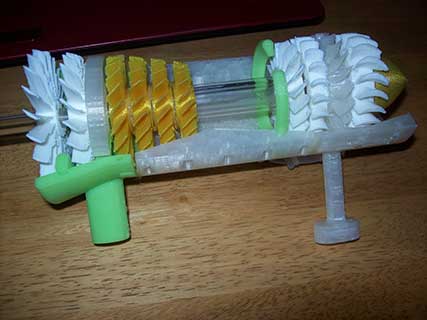
3D Printing: Science Fiction Made Real
By: J.D. Williams & Kiernan Manion
If you have ever watched the science fiction TV show Star Trek: The Next Generation, you may have seen the cast use a machine called a ‘replicator’ to create synthetic items almost out of thin air. According to the show, replicator technology would not be available until the 24th century. It worked by rearranging subatomic particles, forming molecules and arranging them into the objects you request. The U.S.S. Enterprise crew used the replicator to create food, but in later episodes, and on other Star Trek shows, it was used to create non-food objects. Similar technology was referenced in other science fiction works like the computer game, Deus Ex and the graphic novel, Transmetropolitan. In truth, there has been real world technology of this kind in development since 1984, with it now being broadly utilized for military, business and consumers alike.
3D printing is one of the newest and most intriguing advances in technology. Hundreds of news reports, online articles and everyday conversations are fueled by advancing technologies. The concept of creating an object out of thin air, however, was an afterthought written off as science-fiction.
The technology behind three-dimensional printing began development as early as the 1980s. Today, this technology has become accessible and has already been adopted for mainstream use, including in the military.
This innovative manufacturing process could revolutionize the way objects are created and duplicated. Small business owners, especially in retail and manufacturing, should know the essentials of how this process works and how it could affect their business.
What is 3D Printing?
3D printing, also called “additive manufacturing,” is a process to make three-dimensional solid objects from a digital file. Using additive processes, a 3D printer places multiple layers of material until an entire object is created. Each layer serves as a thinly-sliced cross-section of the new object.
The 3D printing process begins with a virtual design. A CAD (Computer Aided Design) file is made from using a 3D modeling program to develop a new object. Alternatively, a 3D scanner is used to copy an existing object by creating a 3D digital copy and placing it into the modeling software.
The digital file is prepared for print through slicing the design into thousands of horizontal layers, rendered in 2D. Then, this file is uploaded to the 3D printer (much like a document is sent to a conventional paper printer) and additive manufacturing creates the object layer by layer. The process creates a three dimensional product from blending each slice together with no visible sign of layering.
Each 3D printer differs in the way it produces an object, mainly in the creation of the layers. Selective laser sintering (SLS, an application of plastic extrusion) and fused deposition modeling (FDM) are the most common technologies. Today, the terms “3D printing” and “additive manufacturing” are commonly used as an all-encompassing term to represent these technologies.
The rapid implementation of 3D printing is taking the manufacturing industry to new heights. Much like the personal computer and assembly line revolutionized the business world, 3D printing can impact your business on many levels.
How can 3-D Printing Benefit Small Businesses?
The 3-D printing industry generates at least $3 billion in products and services, according to the 2014 Wohler report. 3D Printers are becoming more and more affordable. 3D Systems’ Cubepro is a desktop-sized printer that retails at about $5000.
The good news is, Hewlett-Packard is planning a massive line of compact 3D Printers that are perfect for small businesses. With this technology becoming more accessible, there are a number of ways to use this accessibility to maximize your small business operation.
Niche products that are not readily available at large retailers can be specially made and available for sale and use at your business at a low cost.
Prototypes can be built and tested without the need for costly one-off manufacturing processes. You can 3D print your prototype and have a physical representation of your idea to present to potential investors, or to test out and see if it is suitable for mass manufacturing and distribution. Also, entrepreneurs can have their prototypes ready to go in hours, as opposed to days. They additionally now have the option of producing it themselves as opposed to waiting for an outsourced manufacturer to produce it.
Products can be customized with changes built right into the CAD design file. This is an excellent option for promotional operations and branding. This customization can also eliminate producing more of a specific item than is actually needed.
Owners can also create replacement parts for any machines frequently used in their business, if and when, they break down. No more paying outrageous prices for small, obscure parts!
3D Printers enable print-on-demand inventory, which eliminates the need to keep too much of an item in stock, which is very important if you have limited storage space. Another idea is to offer unique, new 3D printed products directly to the consumer through 3D printing shops, now available to a vast, established market, offered by Amazon and Target, to name just a few sources.
3D Printing in-house vs. outsourcing
When deciding whether to purchase a 3D printer, keep in mind that the material of choice for most non-food printers is plastic, which makes durability something to factor in when making your decision. Also, it may take hours to create a product, where with traditional process, you can create more of that product in minutes. If you choose to do your 3D printing in-house, you are also going to need to either know a thing or two about CAD design, or have someone on your staff who does. So you might have to weigh the cost of added training and/or personnel to the cost of acquiring a 3D printer. The costs of printing materials and acquiring CAD files you are unable to produce in-house must also be accounted for.
There are also services available that can handle your 3D printing needs for you. When looking over the companies that offer it, you must give them the same scrutiny you would give to any other outsourced service. Compare factors such as selection of materials, turnaround time, product quality and price. There are also a variety of different additive processes for your 3D printing needs, so you will also need to understand how your product is to be utilized, and compare which processes work best for your product.
3D printing offers next-generation technology that creates a plethora of options and possibilities to help increase your bottom line. If utilized correctly, 3D printing can help minimize operating costs, carve out unique niches and create new business opportunities. Live long and prosper!



